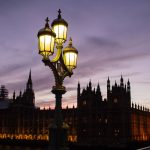More than one in four UK households will be in fuel poverty once Ofgem’s latest energy price cap rise comes into effect, according to estimates from the Resolution Foundation.
Energy bills are forecast to rise by more than £600 a year for a typical household – from £1,277 to nearly £2,000.
That would mean an increase of more than 50% – more than four times the previous biggest rise of £139, which came into effect in October last year.
A household is in fuel poverty if occupants spend more than 10% of their income on energy bills after paying rent or mortgage.
The £600 is an average – for many households, including those at the poorest end of the scale, the number will be higher.
Sky News has analysed the areas where low-income and high bills could leave some people struggling more than other.
This map shows the parts of the country that have the biggest fuel bills. The top 5% are highlighted green, many of them are rural areas with larger, detached homes, which are more expensive to heat.
We can overlay that map with the parts of the country that are in the lowest 5% by income – in blue here. They’re a bit smaller and harder to make out, because they are largely city areas.
The only part of the country where these two measures overlap is West Yorkshire, with Bradford as the epicentre.
Why is Bradford so badly affected?
Part of the reason is the way Bradford’s houses are built.
Lots of traditional Yorkshire-brick homes are built in a way that makes them difficult to heat, and the way they have been converted can make that problem worse.
“If your house was built before the 1950s, it’s likely your house will have just one outer wall,” explained Lucie Middlemiss, professor of environment and society at Leeds University.
“If you don’t have a wall cavity, you can’t insulate it. If you’ve converted your loft to an extra bedroom you can’t insulate that either.
“You can pay to insulate on the outside – external wall insulation – but it’s expensive and it changes the aesthetic of the home. It’s about £10,000 for a three-bed so the government grants don’t cover it.”
Emma Heron lives in Bradford with her partner John in a traditional back-to-back terrace house.
“It’s just really cold, even if you have the heating on it’s still really cold,” she said.
“When there’s no heating it’s hard because you feel freezing. I put extra clothes on, we get under the quilt and get a hot water bottle. It’s so cold and we just sit there shaking.”
She said she often faces a choice between buying food and putting money in the meter.
“I got a few bits of food but that didn’t last at all,” she said.
“My mum put some money in my bank account because she knew I was struggling. She put in £20, I used £10 on food and £10 on gas. It didn’t last long.
“Our gas and electric bill has gone up. And it’s a lot of money. How am I going to get that? Normally I get £700 and I split it on bills, food, stuff like that – what you need to do basically.”
The release of official fuel poverty figures are delayed by years, meaning it’s hard to tell which areas are most at risk now.
It’s clear that households in the South East are better off than those in other parts of the country, but the issue is not unique to Bradford.
Alifjane Begum lives with her three children in Dagenham, east London, which was one of the worst-affected areas the last time the data was updated.
It is also one of the parts of the country where it is hardest to find alternative housing.
Charles Trew, head of policy at housing charity Shelter, said London is currently losing more social housing than it can build.
“What we’re left with is terrible temporary accommodation and run-down older homes,” he said.
Alifjane lives in a modern block, but that doesn’t mean it’s any better than that older housing in Yorkshire.
“From the outside it basically looks like a shipping container. There is condensation and mould, which affects [the children’s] health.
“My five-year-old is asking why it’s smelling in their room. I’m always cleaning but that has caused me health problems because I’m inhaling the damp and when the night comes I’m gasping for breath.”
Ability to pay
Heating struggles are not just due to poor quality housing. They also come down to money.
Alifjane left her job after her daughter injured herself at home while she was on shift. She is on universal credit and her husband is a taxi driver.
“I put in whatever I can afford [to the electricity meter]. That could be just £2 or £4, but that means I have to take something off the budget.
“My six-year-old has a torch. If she wakes up in the night she uses that to go to the toilet, so she doesn’t have to turn on all of the lights. It’s something she shouldn’t be thinking about at her age.
“When [the children] start coughing in the night it breaks me to think about. I’m upset about putting my kids in that situation. I wish I could do something to change it for them. Sometimes I regret even having them.”
What is the government doing to help?
Support can be divided into two categories.
In the short term, there is help available for the most vulnerable, such as the warm homes discount or the winter fuel allowance.
Longer term, there are schemes to pay for things such as insulation and new boilers, such as the energy company obligation, which will lower energy costs in future years.
There is some cause for optimism – in 2010, just 14.6% of low-income homes were fuel efficient (band C or higher), a figure that rose to nearly half by 2019. A majority of homes are still in the failing categories, however.
And help isn’t always being targeted most effectively to those who need it. Analysis by geospatial technology company Kamma showed that the gap between the most and least efficient regions has actually grown in the past 10 years.
Juliet Phillips, a senior policy adviser at climate change think-tank E3G, said the UK still has the coldest and leakiest buildings in Europe.
Another scheme, the Green Homes Grant, was cut last year due to administrative issues – partly to do with it being poorly targeted. Ms Phillips said that this had left the sector short of funding, meaning the Conservatives are not on target to deliver key manifesto pledges from 2019.
Simon Francis, from the End Fuel Poverty Coalition, said that more comprehensive help was needed as eligibility spreads to potentially a quarter of households.
“We need immediate support as well as long-term investment.
“If you have six million people in need of assistance, it becomes unrealistic to pay for all of those. The current schemes don’t have enough financial support.
“That’s when one-off payments to help failing energy providers might be more attractive.”
The Data and Forensics team is a multi-skilled unit dedicated to providing transparent journalism from Sky News. We gather, analyse and visualise data to tell data-driven stories. We combine traditional reporting skills with advanced analysis of satellite images, social media and other open source information. Through multimedia storytelling we aim to better explain the world while also showing how our journalism is done.






















